In an ever-changing world, the effects of climate change have become more pronounced, impacting various aspects of our lives.

One significant area that has been affected is homeowners insurance. With climate change comes greater risk and a potentially higher cost of home insurance. As climate-related incidents increase in frequency and intensity, homeowners are faced with new challenges and considerations when it comes to protecting their most valuable asset-their homes.
In today’s rapidly evolving world, the impact of climate change is becoming increasingly evident. As homeowners, it’s crucial to recognize and address the potential risks that come hand in hand with these environmental shifts.
Table of Contents
Understanding Climate Change and Its Impact
Climate change, driven by human activities such as deforestation, industrialization, and greenhouse gas emissions, has led to a series of transformative shifts in our environment. Rising global temperatures, extreme weather events, and sea-level rise are just a few of the consequences we now face. As responsible homeowners, it’s imperative to comprehend the direct and indirect impacts these changes can have on your property and the subsequent implications for your insurance coverage.
The Evolution of Homeowners Insurance
Traditional homeowners insurance policies were designed with historical weather patterns in mind, which may no longer hold true in the face of rapid climate change. It’s crucial to review your policy and engage in a proactive conversation with your insurance provider to understand how these shifts might affect your coverage. This process of evaluation and adjustment ensures that you remain adequately protected against emerging risks.
With the changing climate landscape, homeowners insurance has undergone significant transformations. Insurers have had to reevaluate risk assessment and coverage options to adapt to the growing threat of climate-related incidents. Understanding these changes is crucial for homeowners to ensure they have adequate protection.
1. Risk Assessment and Premiums
Each geographical location is unique in terms of the climate risks it faces. From hurricanes and floods to wildfires and extreme heat, identifying the vulnerabilities specific to your region is a pivotal first step. Collaborating with climate scientists and insurance professionals can aid in comprehending the risks your property is exposed to, enabling you to make informed decisions about your coverage needs.
Insurance companies now incorporate advanced modeling techniques to assess the risk of climate-related events in specific regions. Areas prone to hurricanes or wildfires may experience higher premiums, reflecting the elevated risk. Homeowners should be aware of these factors when seeking insurance coverage.
2. Coverage for Climate-Related Damage
Armed with a deeper understanding of your property’s vulnerabilities, it’s time to tailor your homeowners insurance to address these climate-related risks effectively. This might entail additional coverage options, such as flood insurance, windstorm coverage, or even specialized policies to safeguard against the growing threat of wildfires. By customizing your coverage, you ensure that your financial well-being remains intact in the face of unforeseen climate-related events.
Traditional homeowners insurance may not always provide sufficient coverage for climate-related damage. It’s important for homeowners to explore additional coverage options, such as flood insurance, to safeguard against the financial impact of unforeseen events.
Understanding Climate Change-Driven Homeowners Insurance Challenges

The changing climate landscape brings forth a range of challenges that directly affect homeowners and their insurance needs. Let’s delve into some key aspects:
Rising Sea Levels and Coastal Property Vulnerability
Coastal properties face heightened vulnerability as rising sea levels increase the risk of flooding and storm-related damage. Traditional homeowners insurance may not fully cover these perils.
Increased Frequency of Severe Weather Events
The uptick in extreme weather events—such as hurricanes, wildfires, and heavy rainfall—raises concerns about property damage and the availability of comprehensive coverage.
Shifting Patterns in Risk Assessment
Insurance providers are recalibrating risk assessment models to account for changing climate patterns. This can lead to fluctuations in coverage availability and premiums.
The Complexities of Water Damage
Water damage, whether from flooding, heavy rainfall, or burst pipes, poses a significant threat to homes. Understanding coverage options for water-related incidents is crucial.
Securing Your Home and Future: Adapting to Climate Challenges
As a homeowner, it’s essential to take proactive steps to mitigate the risks posed by climate change. Here are some strategies to consider:
1. Home Maintenance and Upgrades: Invest in Resilience-Boosting Home Upgrades
Regular home maintenance can significantly reduce the risk of climate-related damage. Implementing home improvements such as reinforced roofing, storm shutters, and elevated foundations can enhance your home’s resilience against climate-related risks. Clearing gutters, reinforcing the roof, and using fire-resistant materials are effective measures to protect your home from potential hazards.
2. Embracing Sustainability
Reducing your home’s carbon footprint not only contributes to environmental preservation but also positions you as a responsible homeowner. Installing solar panels, enhancing insulation, and using energy-efficient appliances can lower your risk profile in the eyes of insurers. Design your landscaping with climate resilience in mind. Drought-resistant plants, proper drainage, and erosion control can minimize potential damage.
3. Emergency Preparedness: Strengthening Community Engagement
Creating a comprehensive emergency plan is crucial for any homeowner. This includes knowing evacuation routes, preparing an emergency kit, and staying informed about local weather patterns. Being proactive can help minimize potential damage. Collaborate with local community initiatives focused on climate resilience. Collective efforts can lead to more comprehensive disaster preparedness.
FAQs
Is homeowners insurance sufficient to cover climate-related risks?
While traditional homeowners insurance provides essential coverage, it may fall short in addressing all climate-related risks. Exploring additional endorsements or policies tailored to specific perils is advisable.
How do I know if my area is prone to climate-related risks?
Research local climate data, historical weather patterns, and projections to assess your area’s susceptibility to climate risks. Consulting experts and community resources can also provide valuable insights.
Can I retrofit my existing home to be more climate-resilient?
Absolutely. Retrofitting measures, such as reinforcing the roof, updating windows and doors, and improving insulation, can significantly enhance your home’s ability to withstand climate challenges.
Are there insurance options for homes in high-risk areas?
Yes, some insurance providers offer coverage specifically designed for high-risk areas. These policies may include added protections against flood, wildfire, or other climate-related perils.
How can I ensure my home is adequately protected against flooding?
In addition to traditional homeowners insurance, consider purchasing a separate flood insurance policy. This coverage is essential for homes in flood-prone regions.
How often should I review and update my homeowners insurance in light of climate change?
Regularly reviewing your homeowners insurance is crucial, especially in the face of changing climate risks. Aim to assess your coverage annually and after significant climate-related events.
Conclusion
In the face of climate change, homeowners insurance has become an integral part of protecting your property and financial well-being. Understanding the evolving landscape, assessing your risk, and implementing strategic measures will empower you to navigate the challenges posed by climate-related incidents. As you embark on this journey, remember that staying informed and proactive is the key to securing a resilient future for your home and loved ones and beware of insurance frauds happening these days! Stay alert, stay informed!




5 thoughts on “Shocking Impact of Climate Change on Homeowners Insurance: Navigating Future Risks”
Hey there! I’ve been following your blog for a long time
now and finally got the bravery to go ahead and give you a shout out from Huffman Texas!
Just wanted to mention keep up the excellent job!
We feel great & encouraged when we receive comments like this! Thanks for sharing your comments.
Fantastic web site. A lot of useful information here.
I am sending it to several friends ans additionally sharing in delicious.
And obviously, thanks in your effort!
We are truly thankful for your support! Thanks for sharing your valuable feedback. It means a lot!